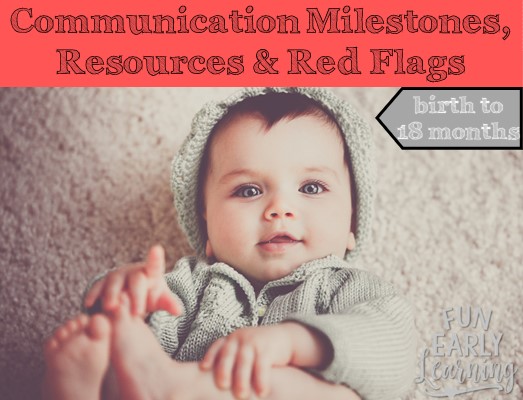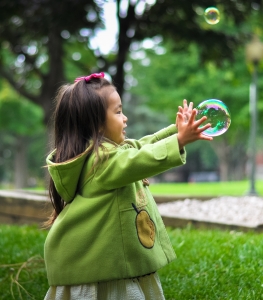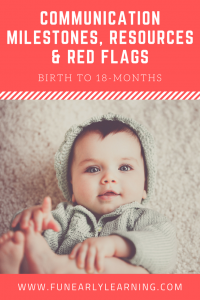
Below is a list of communication milestones, resources and red flags to look for as you determine the best course of action for your child. Most children will acquire new skills following a predictable progression of speech and language development. It’s important to remember that if your child has not mastered a certain skill by the suggested age, or is slightly delayed in a few of the milestone areas, it doesn’t necessarily indicate a speech or language disorder.

Please contact your family doctor for an evaluation, or a speech-language pathologist for a screening if you are concerned about your child’s communication skills. You can also check with local community associations, universities, health departments and preschools to see if they offer free hearing, speech and language development screenings in your community.
Communication Milestones, Resources and Red Flags – Birth to 18 Months
| Birth -2 months | Unintentional sounds; attempts to use his/her voice, but productions are not speech |
| 2-4 months | Cooing – produces vowel-like sounds, (e.g., “ooh” and “ahh”) |
| 3-6 months | Marginal babbling emerges – consonant-vowel (CV) or vowel-consonant (VC) sound combinations (e.g., “uuum”, “baaaa”, or “maaa”) |
| 6-10 months | Canonical babbling emerges – consonant-vowel combinations (e.g., “da-da-da”, “ma-ma-ma” or “ba-ba-ba”).
Canonical babbling may go hand-in-hand with other normal baby noises including cries, squeals, grunts, and gurgles. Red Flags Failure to babble or late-onset of canonical babbling. Canonical babbling is a precursor to the development of meaningful speech. Failing to babble or delays in the onset of canonical babbling have been associated with both delayed language development and hearing impairment. Canonical babbling does not begin until after 11 months for children at risk for severe to profound hearing loss or speech and language disorders. |
| 8-12 months | Understands three to 50 words
Red Flags
|
| 12-18 months |
Red Flags
|
What Can I Do to Help My Child Develop Language Skills?
- Talk while you are doing things so your child will hear your words (e.g., “Daddy is making dinner. The potatoes are so yummy! Mommy is washing the table.”)
- Talk while you are going places or outside (e.g., “That is a tree. That is a bird. Look at the blue sky.”)
- Imitate your child’s vocalizations
- Check to see if your child reacts to sounds (e.g., turns head toward clapping sounds and responds to your voice.)
- Play games your child can learn to imitate such as pat-a-cake and peek-a-boo
- Teach animal sounds (e.g., “A pig says “oink.”)
- Read books with your child daily and include rhyming text and animal sounds. Talk about sounds in the text, (e.g., “The car goes v-v-v-v-vroom! The pig says, “Oink”).
- Use sounds in play (e.g., blow bubbles and make the “b” sound – “buh, buh, bubbles.”)
- Help to build vocabulary and language skills by saying the name of pictures or objects your child points to.
- Expand on conversations (e.g., if your child says “baby,” you respond by saying, “Yes, that’s a little baby.”
What Can I Do to Help My Child Develop Language and literacy Skills?
That’s a very common question that we get. Click here to find out what you can do to help your child’s language and literacy development.

Adapted from: LinguiSystems Guide to Communication Milestones
Retrieved from https://www.linguisystems.com/pdf/Milestonesguide.pdf
The information contained on this website should not be used as a substitute for the medical care and advice of your pediatrician or Speech Language Pathologist.

